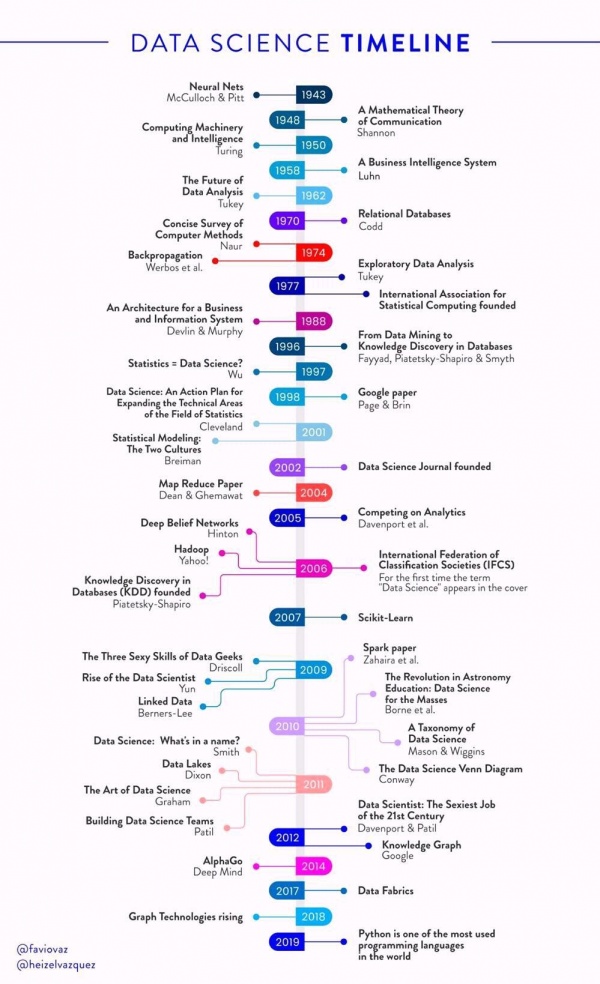Difference between revisions of "Data Science: Sejarah"
Jump to navigation
Jump to search
Onnowpurbo (talk | contribs) (Created page with " [File:History-data-science.jpg|center|600px|thumb|Sejarah Data Science]] ==Pranala Menarik== * Data Science") |
Onnowpurbo (talk | contribs) |
||
| (One intermediate revision by the same user not shown) | |||
| Line 1: | Line 1: | ||
| − | [File:History-data-science.jpg|center|600px|thumb|Sejarah Data Science]] | + | [[File:History-data-science.jpg|center|600px|thumb|Sejarah Data Science]] |
| + | |||
| + | |||
| + | |||
| + | |||
| + | The figure presents a '''Data Science Timeline''', highlighting key milestones in the evolution of data science from 1943 to 2019. It categorizes important breakthroughs, research papers, and technological advancements that have shaped the field. | ||
| + | |||
| + | =='''Early Foundations (1943 - 1970)'''== | ||
| + | * The journey begins with '''Neural Nets''' (McCulloch & Pitt, 1943) and '''Computing Machinery and Intelligence''' (Turing, 1950), setting the foundation for artificial intelligence. | ||
| + | * '''Claude Shannon's''' work on the '''Mathematical Theory of Communication''' (1948) influenced how data is transmitted and processed. | ||
| + | * The 1960s saw developments in '''Business Intelligence Systems''' (Luhn, 1958) and '''Data Analysis''' (Tukey, 1962). | ||
| + | * '''Relational Databases''' (Codd, 1970) introduced structured ways to store and manage data. | ||
| + | |||
| + | =='''Advancements in Data Science (1974 - 2000)'''== | ||
| + | * '''Backpropagation''' (Werbos et al., 1974) became a key algorithm for training neural networks. | ||
| + | * '''Exploratory Data Analysis''' (Tukey, 1977) promoted visual methods for data understanding. | ||
| + | * '''International Association for Statistical Computing''' (1977) signaled the growing importance of computational statistics. | ||
| + | * The 1990s introduced '''Knowledge Discovery in Databases (KDD)''' and the transition from '''Data Mining to Knowledge Discovery''' (Fayyad, 1996). | ||
| + | * Google’s '''Page & Brin (1998) paper''' revolutionized web search algorithms. | ||
| + | |||
| + | =='''Modern Data Science (2001 - 2010)'''== | ||
| + | * '''Deep Learning''' gained traction with '''Deep Belief Networks''' (Hinton, 2005). | ||
| + | * '''Hadoop''' (2006) enabled big data storage and processing. | ||
| + | * The term '''“Data Science”''' officially appeared on the cover of the '''International Federation of Classification Societies (IFCS)''' journal (2006). | ||
| + | * '''Scikit-Learn''' (2007) simplified machine learning implementation. | ||
| + | * The rise of '''Linked Data''' (Berners-Lee, 2009) improved the integration of web data. | ||
| + | |||
| + | =='''Recent Developments (2011 - 2019)'''== | ||
| + | * The '''Data Science Venn Diagram''' (Conway, 2010) categorized data science skills. | ||
| + | * '''"Data Scientist: The Sexiest Job of the 21st Century"''' (Davenport & Patil, 2012) increased the profession's popularity. | ||
| + | * '''AlphaGo (DeepMind, 2014)''' demonstrated AI’s capabilities in complex games. | ||
| + | * '''Python''' became the dominant programming language for data science (2019). | ||
| + | |||
| + | The timeline illustrates how data science has evolved from foundational theories to advanced AI-driven technologies, shaping industries and research fields. | ||
| + | |||
| + | |||
| + | |||
==Pranala Menarik== | ==Pranala Menarik== | ||
* [[Data Science]] | * [[Data Science]] | ||
Latest revision as of 14:40, 11 February 2025
The figure presents a Data Science Timeline, highlighting key milestones in the evolution of data science from 1943 to 2019. It categorizes important breakthroughs, research papers, and technological advancements that have shaped the field.
Early Foundations (1943 - 1970)
- The journey begins with Neural Nets (McCulloch & Pitt, 1943) and Computing Machinery and Intelligence (Turing, 1950), setting the foundation for artificial intelligence.
- Claude Shannon's work on the Mathematical Theory of Communication (1948) influenced how data is transmitted and processed.
- The 1960s saw developments in Business Intelligence Systems (Luhn, 1958) and Data Analysis (Tukey, 1962).
- Relational Databases (Codd, 1970) introduced structured ways to store and manage data.
Advancements in Data Science (1974 - 2000)
- Backpropagation (Werbos et al., 1974) became a key algorithm for training neural networks.
- Exploratory Data Analysis (Tukey, 1977) promoted visual methods for data understanding.
- International Association for Statistical Computing (1977) signaled the growing importance of computational statistics.
- The 1990s introduced Knowledge Discovery in Databases (KDD) and the transition from Data Mining to Knowledge Discovery (Fayyad, 1996).
- Google’s Page & Brin (1998) paper revolutionized web search algorithms.
Modern Data Science (2001 - 2010)
- Deep Learning gained traction with Deep Belief Networks (Hinton, 2005).
- Hadoop (2006) enabled big data storage and processing.
- The term “Data Science” officially appeared on the cover of the International Federation of Classification Societies (IFCS) journal (2006).
- Scikit-Learn (2007) simplified machine learning implementation.
- The rise of Linked Data (Berners-Lee, 2009) improved the integration of web data.
Recent Developments (2011 - 2019)
- The Data Science Venn Diagram (Conway, 2010) categorized data science skills.
- "Data Scientist: The Sexiest Job of the 21st Century" (Davenport & Patil, 2012) increased the profession's popularity.
- AlphaGo (DeepMind, 2014) demonstrated AI’s capabilities in complex games.
- Python became the dominant programming language for data science (2019).
The timeline illustrates how data science has evolved from foundational theories to advanced AI-driven technologies, shaping industries and research fields.
